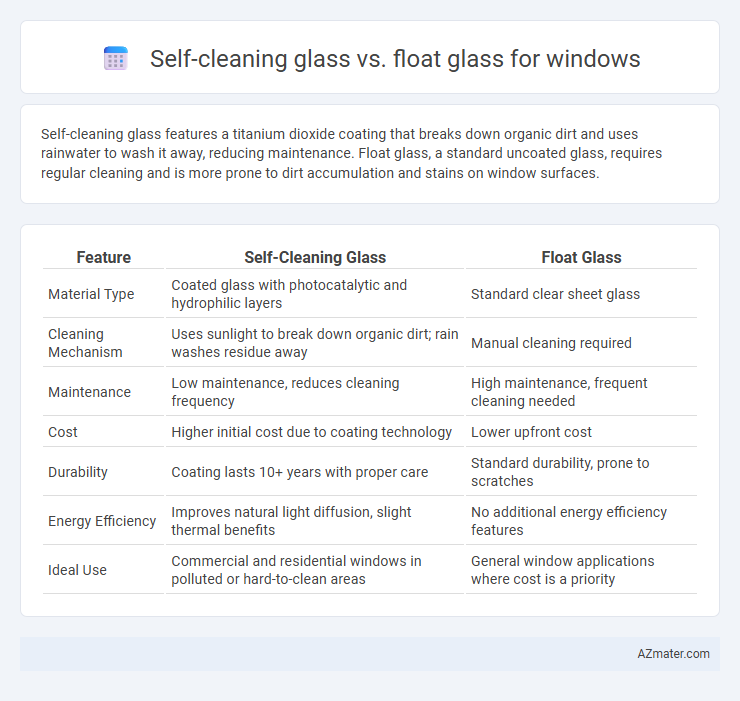Self-cleaning glass features a titanium dioxide coating that breaks down organic dirt and uses rainwater to wash it away, reducing maintenance. Float glass, a standard uncoated glass, requires regular cleaning and is more prone to dirt accumulation and stains on window surfaces.
Table of Comparison
| Feature | Self-Cleaning Glass | Float Glass |
|---|---|---|
| Material Type | Coated glass with photocatalytic and hydrophilic layers | Standard clear sheet glass |
| Cleaning Mechanism | Uses sunlight to break down organic dirt; rain washes residue away | Manual cleaning required |
| Maintenance | Low maintenance, reduces cleaning frequency | High maintenance, frequent cleaning needed |
| Cost | Higher initial cost due to coating technology | Lower upfront cost |
| Durability | Coating lasts 10+ years with proper care | Standard durability, prone to scratches |
| Energy Efficiency | Improves natural light diffusion, slight thermal benefits | No additional energy efficiency features |
| Ideal Use | Commercial and residential windows in polluted or hard-to-clean areas | General window applications where cost is a priority |
Introduction to Window Glass Technologies
Self-cleaning glass utilizes a photocatalytic coating that breaks down organic dirt when exposed to sunlight, reducing manual cleaning efforts and maintaining clarity. Float glass, produced by floating molten glass on a bed of molten tin, offers a smooth surface and uniform thickness ideal for standard windows. Advances in window glass technologies integrate these materials to enhance durability, energy efficiency, and maintenance convenience.
What is Float Glass?
Float glass is a type of flat glass made by floating molten glass on a bed of molten metal, usually tin, resulting in a smooth and uniform thickness sheet ideal for windows and architectural applications. Unlike self-cleaning glass, which features a special coating that breaks down dirt and allows rainwater to wash it away, float glass has no additional functional treatment and requires manual cleaning. Its clarity and strength make it a versatile base material for various glazing options, including further coatings for enhanced properties.
What is Self-Cleaning Glass?
Self-cleaning glass features a special titanium dioxide coating that reacts with sunlight to break down organic dirt and uses rainwater to wash away debris, significantly reducing maintenance efforts. Unlike standard float glass, which lacks this coating and requires regular manual cleaning, self-cleaning glass maintains clearer transparency over time. This innovative technology enhances window durability and visual clarity in residential and commercial buildings.
How Self-Cleaning Glass Works
Self-cleaning glass utilizes a special photocatalytic coating, typically titanium dioxide, which activates under sunlight to break down organic dirt and contaminants on the surface. This coating also makes the glass hydrophilic, causing rainwater to spread evenly and wash away the loosened debris more effectively compared to float glass. Consequently, self-cleaning glass reduces maintenance efforts and ensures clearer windows over time.
Key Differences Between Self-Cleaning Glass and Float Glass
Self-cleaning glass features a special coating that uses sunlight to break down organic dirt and a hydrophilic surface allowing rainwater to wash away residues, significantly reducing maintenance compared to standard float glass. Float glass, produced by floating molten glass on a bed of molten metal, lacks these advanced coatings and requires frequent manual cleaning to maintain clarity and performance. The durability, energy efficiency, and long-term cost savings of self-cleaning glass make it a superior choice for windows in environments prone to dirt and pollution.
Benefits of Self-Cleaning Glass for Windows
Self-cleaning glass for windows offers significant benefits by reducing the need for manual cleaning through its photocatalytic and hydrophilic coatings, which break down organic dirt and allow rainwater to rinse away debris effortlessly. This technology enhances window clarity and maintenance efficiency, ultimately extending the lifespan of the glass and reducing labor and cleaning costs compared to conventional float glass. Ideal for both residential and commercial buildings, self-cleaning glass improves energy efficiency by maintaining optimal light transmission and contributes to sustainable building practices by minimizing water and chemical usage.
Advantages of Float Glass in Window Applications
Float glass offers superior clarity and uniform thickness, ensuring optimal light transmission and aesthetic appeal in window applications. Its high mechanical strength and flexibility make it highly durable against environmental stress and impact. Cost-effectiveness and ease of fabrication allow float glass to be efficiently customized for various architectural designs while providing excellent thermal insulation properties.
Maintenance and Longevity Comparison
Self-cleaning glass features a titanium dioxide coating that breaks down organic dirt when exposed to sunlight, reducing cleaning frequency compared to traditional float glass, which requires regular manual cleaning to maintain clarity. Over time, the self-cleaning layer maintains its effectiveness for about 10 years, significantly extending the period between cleanings and preserving window appearance, whereas float glass may accumulate dirt and stains that accelerate wear and compromise longevity. Maintenance costs for windows with self-cleaning glass are lower due to reduced cleaning needs, making it a cost-effective, durable choice for long-term window performance.
Cost Analysis: Self-Cleaning Glass vs Float Glass
Self-cleaning glass commands a higher initial investment, typically costing 30-50% more than standard float glass due to its specialized coating technology. Over time, the reduction in cleaning labor and maintenance expenses can offset this upfront cost, especially in commercial or hard-to-reach installations. Float glass, while more affordable initially, incurs ongoing cleaning costs, making self-cleaning glass a cost-effective solution in environments where maintenance accessibility is limited or aesthetics are prioritized.
Which Glass is Best for Your Windows?
Self-cleaning glass reduces maintenance with its hydrophilic coating that breaks down dirt and repels water, making it ideal for hard-to-reach windows. Float glass offers a cost-effective, clear option but requires regular cleaning and provides no special dirt-repelling features. Choosing between self-cleaning and float glass depends on budget, window location, and the priority placed on ease of maintenance versus initial cost.

Infographic: Self-cleaning glass vs Float glass for Window
 azmater.com
azmater.com